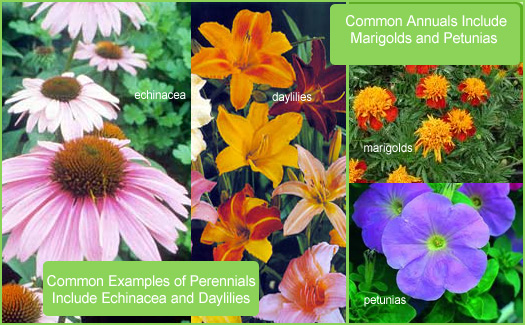The Big Debate - Perennials vs. Annuals in Your New England Garden
Last Updated:
We're Not Taking Sides!
What the Heck is the Difference Between an Annual and a Perennial Anyway? The short answer is this: annuals are plants that die in the fall and winter and must be regrown from seed each spring. Perennials are plants that lose their leaves each year but their roots and sometimes stems stay alive through the cold winter. In the spring, they regrow without replanting.

Sounds Like Perennials Are the Way to Go, Right? Well, that depends. Both types of plants have their pros and cons, like most things in life. Although perennials only need to be planted once, they often have a much shorter blooming period. This blooming period may only last a week or two per year, and the rest of the time the plant just stays green, or sometimes even dies down to the ground until the following year. In addition, they can spread from year to year, requiring maintenance on your part to lift the plant out of the ground periodically and cut it back to a more manageable size. If the plants are managed properly and you choose varieties that bloom at different times of the spring and summer, you can have a garden with something in bloom all season with relatively little effort on your part. Also, once perennials become established after a year, they usually require less water, since their roots tend to grow much deeper than annuals.
So What Benefits Do Annuals Bring to the New England Garden? In a word, color. Most annuals start blooming in a very short amount of time and continue to do so all the way up until a killing frost in the fall. In most New England garden centers, annuals usually make up the lion's share of the plants, largely because they have a long blooming period and continue to look good during the entire selling season. It can be pretty hard to sell a perennial plant when its just stems and leaves, flowers long gone until next year's growing season. The other great advantage to annuals is that they tend to be much more inexpensive than perennials, and also don't require maintenance from year to year since they die at the end of the season. For these reasons, you'll find that most New England gardens are dominated by annuals.
Experiment With Both Types of Plants in Your New England Garden At the end of the day, what plants you decide to put in your New England garden is your choice. If you are looking for more of a traditional look, perennials often fit the bill much better than annuals for foundation plants. They tend to grow larger and look good in the back of the garden or up against a porch or stone wall. Annuals generally grow less than a foot high (check the tags at the garden center to be sure) and are found in the front of perennials, where they can be seen and give off a steady show of color all season. Have some fun, and experiment with both types of plants now that you know the differences and what to expect from them during the growing season. You'll probably find that you like them both, and will find great spots in the garden for both annuals and perennials each year.